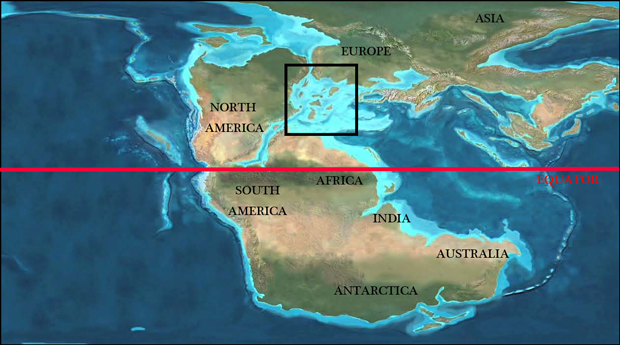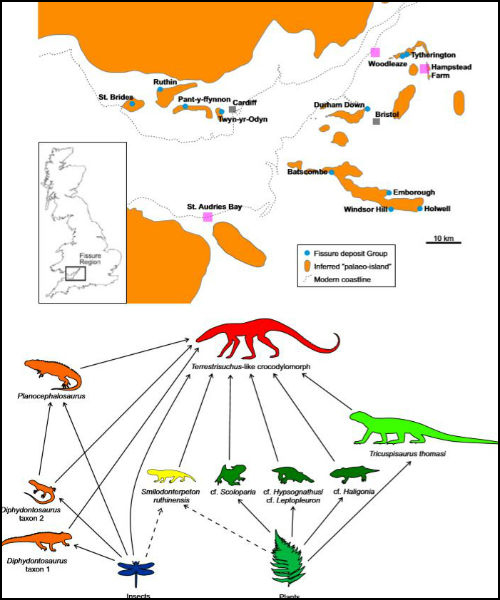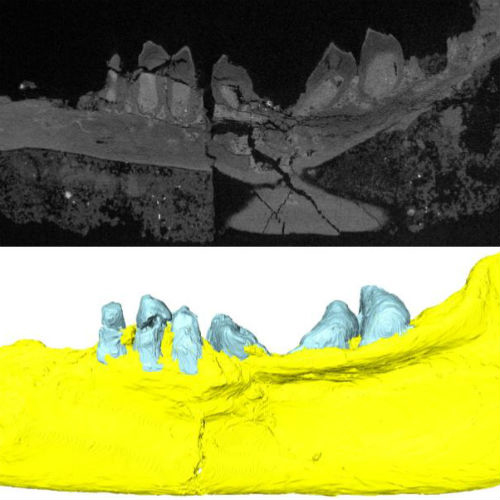New Research Identifies Potential Late Triassic Island Dwarfs
Bristol Channel Could Provide Oldest Evidence of Insular Dwarfism
The flamboyant Baron Franz Nopcsa did much to establish the concept of island dwarfism, that is animals on islands with limited resources often evolve into much smaller forms. Baron Nopcsa was the first person to suggest dwarf dinosaurs based on specimens associated with the Late Cretaceous Hateg Island, but a team of researchers including scientists from Bristol University, have uncovered evidence of island dwarfism in strata laid down in the Upper Triassic millions of years before the Hateg biota evolved.
Late Triassic Island Dwarfs
Writing in the “Proceedings of the Geologists’ Association”, the researchers report on an analysis of fossil remains from strata laid down around 205 million years ago that suggests ancient North American reptiles lived on an island archipelago in the area that now forms South Wales and the Bristol Channel.
Student Matthew Skinner, (School of Earth Sciences at Bristol University), studied a treasure trove of fossil material that had been collected from Ruthin Quarry back in the 1950s and housed as part of the fossil collection at the National Museum of Wales (Cardiff). The fragmentary and very fragile material documented life on a small tropical island during a time in Earth’s history when the Atlantic Ocean did not exist and Europe and North America were only partly separated and what division there was consisted of narrow, shallow seaways dotted with small islands.
World Map (Late Triassic) The Black Square Shows the Approximate Location of the Island Archipelago

Eleven Different Taxa
In total eleven different taxa were identified, many of the vertebrates identified from the Ruthin Quarry fossils were reminiscent of fossils associated with much older strata in North America. The researchers describe the Ruthin Quarry biota as “relictual”, they are the remnants of a population that was once much more widely distributed. The Ruthin Quarry specimens are some 25 million years younger than the similar fossils known from North America.
Matthew Skinner commented:
“We were amazed to discover that most of the Ruthin beasts showed greatest similarity to relatives from North America. Of course, at that time, one could just hop across from South Wales to New York. The islands provided little space and food and so regular-sized animals couldn’t survive on them; the Ruthin animals were all dwarf versions of their closest mainland relatives, maybe half the size on average.”
Professor Mike Benton (Bristol University), who supervised the research study, explained:
“Our other questions were about the effects of island life. We know today that animals on remote islands can evolve in different ways from on the mainland. Often they become smaller, as there is less food, and they might be anachronistic – meaning they are throw-backs to much more ancient animals from the mainland.”
As most of the taxa identified from the site possess closest relatives that are found in much older strata and their body size is small, the scientists have concluded that these fossils record evidence of island dwarfism, also referred to as insular dwarfism. This is the oldest known record of this biological phenomenon.
A New Species – Smilodonterpeton ruthinensis
The team identified cartilaginous fish including the primitive shark Rhomphaiodon minor from a single tooth which helped to date the material. Numerous reptiles were described including parareptiles from the Procolophonidae family, one procolophonid is a new species and has been named Smilodonterpeton ruthinensis (chisel-toothed reptile from Ruthin).
Other reptiles identified include three species of rhynchocephalians (beak lizards, distantly related to the living Tuatara of New Zealand), the herbivore Tricuspisaurus thomasi and archosaurs including a small, predatory crocodylomorph similar to Terrestrisuchus. Although less than a metre in length, this crocodylomorph may have been the top predator on the island. From this inventory, a simple food chain for the Ruthin Quarry fossil site could be constructed.
Location of the Fossil Finds and the Ruthin Quarry Food Chain

Picture credit: Bristol University
CT Scans and Three-Dimensional Computer Models
A number of the delicate fossil specimens were subjected to non-destructive CT scans to help reveal their anatomical details. Tricuspisaurus had been named and scientifically described in 1957, but its taxonomic relationship with other reptiles was unclear. This research has enabled the scientists to challenge the view that Tricuspisaurus was a procolophonid.
Co-author of the paper, Dr David Whiteside (Bristol University and the Palaeontology Department of the London Natural History Museum), stated:
“It has been questioned for many years how Tricuspisaurus is related to the other reptiles. I was keen we found out what it really was, and Matthew was able to CT scan the specimens and this showed that its teeth were located in tooth sockets and it had a beak at the front of its jaws. This confirms it was not a procolophonid, as had been thought, but a distant relative of birds, crocodiles and dinosaurs.”
CT Scan and Digital Image of the Lower Jaw of Tricuspisaurus

Picture credit: Bristol University
For a related article on the Bristol Channel/South Wales archipelago: Getting to Grips with the Jaws of Clevosaurus.
The scientific paper: “Late Triassic island dwarfs? Terrestrial tetrapods of the Ruthin fissure (South Wales, UK) including a new genus of procolophonid” by M. Skinner, D. Whiteside, and M. Benton published in the Proceedings of the Geologists’ Association.
The Everything Dinosaur website: Visit the Everything Dinosaur Website.

